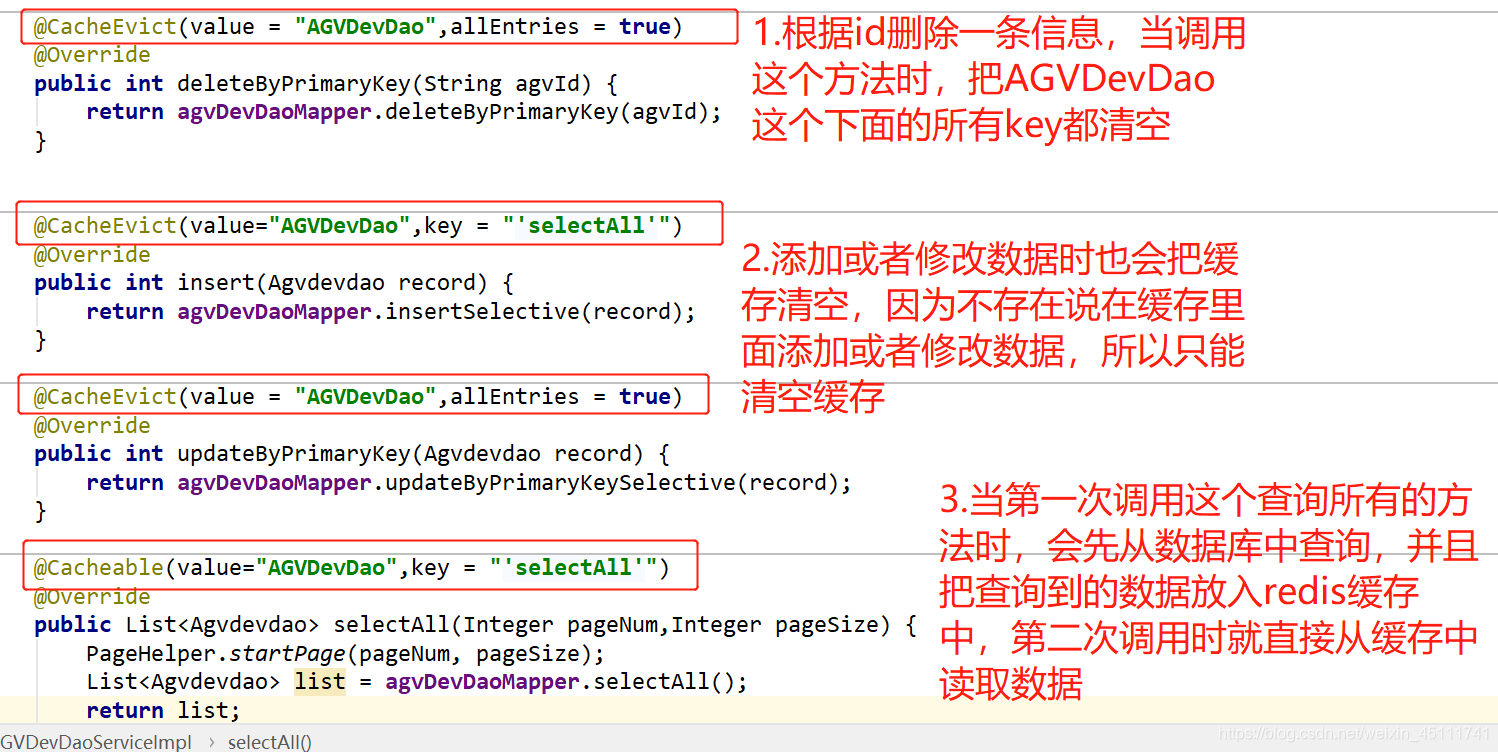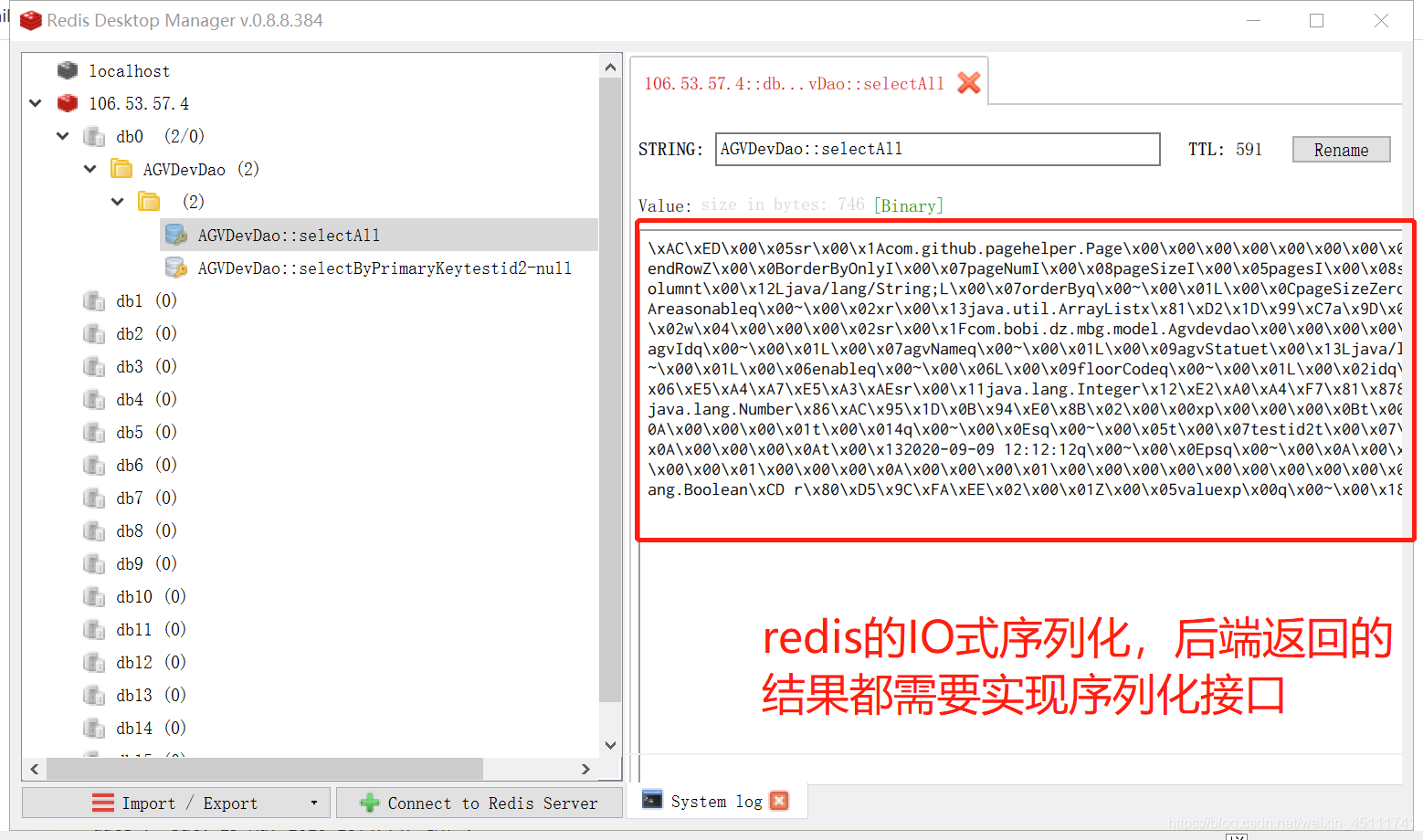SpringBoot整合redis及其注解式开发
1.SpringBoot整合redis注解式简单开发
步骤如下:
①导入pom依赖
<!--redis依赖配置-->
<dependency>
<groupId>org.springframework.boot</groupId>
<artifactId>spring-boot-starter-data-redis</artifactId>
</dependency>
②添加yml配置,在spring下添加
spring:
redis:
host:192.168.190.0 # Redis服务器地址
database: 0 # Redis数据库索引(默认为0)
port: 6379 # Redis服务器连接端口
password: 1234 # Redis服务器连接密码(默认为空)
jedis:
pool:
max-active: 8 # 连接池最大连接数(使用负值表示没有限制)
max-wait: -1ms # 连接池最大阻塞等待时间(使用负值表示没有限制)
max-idle: 8 # 连接池中的最大空闲连接
min-idle: 0 # 连接池中的最小空闲连接
timeout: 3000ms # 连接超时时间(毫秒)
cache: #缓存类型为redis
type: redis
redis:
cache-null-values: false #是否存储空值
time-to-live: 600000ms #设置过期时间
③直接在数据处理层service接口的实现类中加入注解就可以实现缓存啦
直接上代码
package com.bobi.dz.robot.service.impl;
import com.bobi.dz.mbg.mapper.AgvdevdaoMapper;
import com.bobi.dz.mbg.model.Agvdevdao;
import com.bobi.dz.robot.service.AGVDevDaoService;
import com.github.pagehelper.PageHelper;
import org.springframework.beans.factory.annotation.Autowired;
import org.springframework.cache.annotation.CacheEvict;
import org.springframework.cache.annotation.Cacheable;
import org.springframework.stereotype.Service;
import java.util.List;
@Service
public class AGVDevDaoServiceImpl implements AGVDevDaoService {
@Autowired
private AgvdevdaoMapper agvDevDaoMapper;
@CacheEvict(value = "AGVDevDao",allEntries = true)
@Override
public int deleteByPrimaryKey(String agvId) {
return agvDevDaoMapper.deleteByPrimaryKey(agvId);
}
@CacheEvict(value="AGVDevDao",key = "'selectAll'")
@Override
public int insert(Agvdevdao record) {
return agvDevDaoMapper.insertSelective(record);
}
@CacheEvict(value = "AGVDevDao",allEntries = true)
@Override
public int updateByPrimaryKey(Agvdevdao record) {
return agvDevDaoMapper.updateByPrimaryKeySelective(record);
}
@Cacheable(value="AGVDevDao",key = "'selectAll'")
@Override
public List<Agvdevdao> selectAll(Integer pageNum,Integer pageSize) {
PageHelper.startPage(pageNum, pageSize);
List<Agvdevdao> list = agvDevDaoMapper.selectAll();
return list;
}
@Cacheable(value="AGVDevDao",key = "'selectByPrimaryKey'+#agvId")
@Override
public Agvdevdao selectByPrimaryKey(String agvId) {
System.out.println("查询机器人信息。。。。。");
return agvDevDaoMapper.selectByPrimaryKey(agvId);
}
}
代码解释图


如果需要有多个参数的话,可以直接在key的名字后面拼接参数,用一个符号隔开就行

以上就是一个简单的使用redis缓存的流程啦
因为redis是以序列化的形式来缓存的,所以如果需要实现缓存,比较重要的一步就是返回的结果的对象需要实现序列化接口。
但是这是IO式的序列化,看不着实际的内容,像乱码一样

下面我们需要创建JSON序列化器
2.创建redis配置类RedisConfig
package com.bobi.dz.robot.service.config;
import com.fasterxml.jackson.annotation.JsonAutoDetect;
import com.fasterxml.jackson.annotation.PropertyAccessor;
import com.fasterxml.jackson.databind.ObjectMapper;
import org.springframework.cache.CacheManager;
import org.springframework.cache.annotation.CachingConfigurerSupport;
import org.springframework.cache.annotation.EnableCaching;
import org.springframework.cache.interceptor.KeyGenerator;
import org.springframework.context.annotation.Bean;
import org.springframework.context.annotation.Configuration;
import org.springframework.data.redis.cache.RedisCacheConfiguration;
import org.springframework.data.redis.cache.RedisCacheManager;
import org.springframework.data.redis.cache.RedisCacheWriter;
import org.springframework.data.redis.connection.RedisConnectionFactory;
import org.springframework.data.redis.core.RedisTemplate;
import org.springframework.data.redis.core.StringRedisTemplate;
import org.springframework.data.redis.serializer.Jackson2JsonRedisSerializer;
import org.springframework.data.redis.serializer.RedisSerializationContext;
import org.springframework.data.redis.serializer.RedisSerializer;
import org.springframework.data.redis.serializer.StringRedisSerializer;
import java.lang.reflect.Method;
import java.time.Duration;
import java.util.HashMap;
import java.util.HashSet;
import java.util.Map;
import java.util.Set;
/**
* Redis配置类
* Created by macro on 2020/3/2.
*/
@EnableCaching
@Configuration
//继承CachingConfigurerSupport,为了自定义生成KEY的策略。可以不继承。
public class RedisConfig extends CachingConfigurerSupport {
@Bean
public RedisTemplate<String, Object> redisTemplate(RedisConnectionFactory redisConnectionFactory) {
RedisSerializer<Object> serializer = redisSerializer();
RedisTemplate<String, Object> redisTemplate = new RedisTemplate<>();
redisTemplate.setConnectionFactory(redisConnectionFactory);
redisTemplate.setKeySerializer(new StringRedisSerializer());
redisTemplate.setValueSerializer(serializer);
redisTemplate.setHashKeySerializer(new StringRedisSerializer());
redisTemplate.setHashValueSerializer(serializer);
redisTemplate.afterPropertiesSet();
return redisTemplate;
}
@Bean
public RedisSerializer<Object> redisSerializer() {
//创建JSON序列化器
Jackson2JsonRedisSerializer<Object> serializer = new Jackson2JsonRedisSerializer<>(Object.class);
ObjectMapper objectMapper = new ObjectMapper();
objectMapper.setVisibility(PropertyAccessor.ALL, JsonAutoDetect.Visibility.ANY);
objectMapper.enableDefaultTyping(ObjectMapper.DefaultTyping.NON_FINAL);
serializer.setObjectMapper(objectMapper);
return serializer;
}
@Bean
public RedisCacheManager redisCacheManager(RedisConnectionFactory redisConnectionFactory) {
RedisCacheWriter redisCacheWriter = RedisCacheWriter.nonLockingRedisCacheWriter(redisConnectionFactory);
//设置Redis缓存有效期为1天
RedisCacheConfiguration redisCacheConfiguration = RedisCacheConfiguration.defaultCacheConfig()
.serializeValuesWith(RedisSerializationContext.SerializationPair.fromSerializer(redisSerializer())).entryTtl(Duration.ofDays(1));
return new RedisCacheManager(redisCacheWriter, redisCacheConfiguration);
}
//
// @Bean
// public CacheManager cacheManager(RedisConnectionFactory redisConnectionFactory) {
// //通过Spring提供的RedisCacheConfiguration类,构造一个自己的redis配置类,从该配置类中可以设置一些初始化的缓存命名空间
// // 及对应的默认过期时间等属性,再利用RedisCacheManager中的builder.build()的方式生成cacheManager:
// RedisCacheConfiguration config = RedisCacheConfiguration.defaultCacheConfig(); // 生成一个默认配置,通过config对象即可对缓存进行自定义配置
// config = config.entryTtl(Duration.ofMinutes(1)) // 设置缓存的默认过期时间,也是使用Duration设置
// .disableCachingNullValues(); // 不缓存空值
//
// // 设置一个初始化的缓存空间set集合
// Set<String> cacheNames = new HashSet<>();
// cacheNames.add("my-redis-cache1");
// cacheNames.add("my-redis-cache2");
//
// // 对每个缓存空间应用不同的配置
// Map<String, RedisCacheConfiguration> configMap = new HashMap<>();
// configMap.put("my-redis-cache1", config);
// configMap.put("my-redis-cache2", config.entryTtl(Duration.ofSeconds(120)));
//
// RedisCacheManager cacheManager = RedisCacheManager.builder(redisConnectionFactory) // 使用自定义的缓存配置初始化一个cacheManager
// .initialCacheNames(cacheNames) // 注意这两句的调用顺序,一定要先调用该方法设置初始化的缓存名,再初始化相关的配置
// .withInitialCacheConfigurations(configMap)
// .build();
// return cacheManager;
// }
}
只要创建RedisConfig配置类,在配置类中创建json序列化器,那么就会覆盖掉IO式序列化,并且对象可以不需要实现序列化接口了(之前不实现序列化接口的话会报错)

缓存过期时间配置
当我们有多个缓存空间时,我们想给每个缓存设置不同的过期时间的话,需要在RedisConfig中
对每个缓存空间应用不同的配置
@Bean
public CacheManager cacheManager(RedisConnectionFactory redisConnectionFactory) {
//通过Spring提供的RedisCacheConfiguration类,构造一个自己的redis配置类,从该配置类中可以设置一些初始化的缓存命名空间
// 及对应的默认过期时间等属性,再利用RedisCacheManager中的builder.build()的方式生成cacheManager:
RedisCacheConfiguration config = RedisCacheConfiguration.defaultCacheConfig(); // 生成一个默认配置,通过config对象即可对缓存进行自定义配置
config = config.entryTtl(Duration.ofMinutes(1)) // 设置缓存的默认过期时间,也是使用Duration设置
.disableCachingNullValues(); // 不缓存空值
// 设置一个初始化的缓存空间set集合
Set<String> cacheNames = new HashSet<>();
cacheNames.add("my-redis-cache1");
cacheNames.add("my-redis-cache2");
// 对每个缓存空间应用不同的配置
Map<String, RedisCacheConfiguration> configMap = new HashMap<>();
configMap.put("my-redis-cache1", config);
configMap.put("my-redis-cache2", config.entryTtl(Duration.ofSeconds(120)));
RedisCacheManager cacheManager = RedisCacheManager.builder(redisConnectionFactory) // 使用自定义的缓存配置初始化一个cacheManager
.initialCacheNames(cacheNames) // 注意这两句的调用顺序,一定要先调用该方法设置初始化的缓存名,再初始化相关的配置
.withInitialCacheConfigurations(configMap)
.build();
return cacheManager;
}










 本文详细介绍如何在SpringBoot项目中整合Redis实现注解式缓存,包括依赖配置、yml配置、注解使用及JSON序列化器创建,同时讲解缓存过期时间配置。
本文详细介绍如何在SpringBoot项目中整合Redis实现注解式缓存,包括依赖配置、yml配置、注解使用及JSON序列化器创建,同时讲解缓存过期时间配置。

















 被折叠的 条评论
为什么被折叠?
被折叠的 条评论
为什么被折叠?








